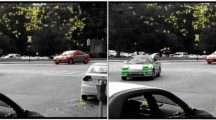Abstract
The smooth representation (SMR) model is a widely used segmentation method in computer vision. This model adopts the K nearest neighbour (KNN) graph to select samples for representation. All neighbours in the KNN graph are assumed to be equally important candidates. In this paper, we use special weights that are calculated by a novel cross-view kernel function to evaluate the contributions of neighbours to the subspace clustering in SMR. The neighbours that are found by the Gaussian similarity formula can be considered long-range similar neighbours. We add another item to accurately reflect the order relation in the cross-view kernel function. This addition allows the kernel function to generalize the conventional SMR method for sequential data. The ordered smooth representation (OSMR) model outperforms other representative space clustering methods on public datasets, namely, the UCI database, the USPS database, Yale B datasets, the Freiburg–Berkeley Motion Segmentation database and a real-world mobile video that was captured by a smart phone.







Similar content being viewed by others
Explore related subjects
Discover the latest articles and news from researchers in related subjects, suggested using machine learning.References
Vidal R (2011) Subspaceclustering. IEEE Signal Process Mag 28(2):52–68
Elhamifar E, Vidal R (2009) Sparse subspace clustering. In: Proceedings of the IEEE conference on computer vision and pattern recognition, Miami, FL, USA, pp 2790–2797
Liu G, Lin Z, Yu Y (2010) Robust subspace segmentation by low-rank representation. In: Proceedings of international conference on machine learning, Haifa, Israel, pp 663–670
Liu G, Yan S (2011) Latent low-rank representation for subspace segmentation and feature extraction. In: Proceedings of the IEEE conference on computer vision and pattern recognition, Barcelona, Spain, pp 1615–1622
Liu G et al (2013) Robust recovery of subspace structures by low-rank representation. IEEE Trans Pattern Anal Mach Intell 35(1):171–184
Chen J, Yang J (2014) Robust subspace segmentation via low-rank representation. IEEE Trans Cybern 44(8):1432–1445
Hu H, Lin Z, Feng J, Zhou J (2014) Smooth representation clustering. In: Proceedings of the IEEE conference on computer vision and pattern recognition, Columbus, OH, USA, pp 3834–3841
Shi J, Malik J (2000) Normalized cuts and image segmentation. IEEE Trans Pattern Anal Mach Intell 22(8):888–905 (2, 4)
Tierney S, Gao J, Guo Y (2014) Subspace clustering for sequential data. In: Proceedings of the IEEE conference on computer vision and pattern recognition, Columbus OH, USA, pp 1019–1026
Wu F, Hu Y, Gao J, Sun Y, Yin B (2015) Ordered subspace clustering with block-diagonal priors. IEEE Trans Cybern 46(12):1–11. https://doi.org/10.1109/TCYB.2015.2500821
Lu CY, Min H, Zhao Z-Q, Zhu L, Yan S (2012) Robust and efficient subspace segmentation via least squares regression. In: Proceedings of the 12th European conference on Computer Vision—Volume Part VII. Springer, Berlin, Heidelberg
Lu C, Feng J, Lin Z, Yan S (2013) Correlation adaptive subspace segmentation by trace lasso. In: Proceedings of the 2013 IEEE International Conference on Computer Vision. https://doi.org/10.1109/ICCV.2013.170
Zhang K, Chao WL, Sha F, Grauman K (2016) Video summarization with long short-term memory. In: European conference on computer vision. Springer, Cham. https://doi.org/10.1007/978-3-319-46478-7_47
Kumar G, Mangathayaru N, Arsimha G (2016) An approach for intrusion detection using novel gaussian based kernel function. J JUCS. https://doi.org/10.3217/jucs-022-04-0589
Mercer J (1909) Functions of positive and negative type and their connection with the theory of integral equations. Philos Trans R Soc London 209:415–446. https://doi.org/10.1098/rsta.1909.0016
Bartels R, Stewart G (1972) Solution of the matrix equation AX + XB = C. Commun ACM 15(9):820–826
Guo XJ (2015) Robust subspace segmentation by simultaneously learning data representations and their affinity matrix. In: Proceedings of the 24th international conference on artificial intelligence. AAAI Press, Palo Alto, 2015, pp 3547–3553
Koltchinskii V, Gin E (2000) Random matrix approximation of spectra of integral operators. Bernoulli 6:113–167
Smale S, Zhou DX (2009) Geometry on probability spaces. Constr Approx 30:311–323
Blake CL, Merz CJ (1998) UCI repository of machine learning databases. University of California, Oakland. http://www.ics.uci.edu/~mlearn
Hull J (1994) A database for handwritten text recognition research. IEEE Trans Pattern Anal Mach Intell 16(5):550–554
Georghiades AS, Belhumeur PN, Kriegman DJ (2001) From few to many: illumination cone models for face recognition under variable lighting and pose. IEEE TPAMI 23(6):643–660
Brox T, Malik J (2010) Object segmentation by long term analysis of point trajectories. In: Computer vision—ECCV 2010, European conference on computer vision, Heraklion, Crete, Greece, September 5–11, 2010, proceedings, DBLP, pp 282–295
Ochs P, Malik J, Brox T (2014) Segmentation of moving objects by long term video analysis. IEEE Trans Pattern Anal Mach Intell 36(6):1187–1200
Bohanec M, Rajkovic V (1988) Knowledge acquisition and explanation for multi-attribute decision making. In: 8th International workshop on expert systems and their applications, Avignon, France, pp 59–78
Zupan B, Bohanec M, Bratko I, Demsar J (1997) Machine learning by function decomposition. In: ICML-97, Nashville, TN, 1997
Waugh S (1995) Extending and benchmarking cascade-correlation. PhD thesis, Computer Science Department, University of Tasmania
Clark D, Schreter Z, Adams A (1996) A quantitative comparison of dystal and backpropagation. In: Submitted to the Australian conference on neural networks (ACNN’96)
Horton P, Nakai K (1996) A probabilistic classification system for predicting the cellular localization sites of proteins. Intell Syst Mol Biol, St. Louis, USA, pp 109–115
Xu J, Xu K, Chen K et al (2015) Reweighted sparse subspace clustering. Comput Vis Image Underst 138:25–37
Acknowledgements
This research work is supported by the Chinese National Natural Science Foundation under Grant Nos. 61976053, 61772134, 61672157, U1805263 and 41601477, Fujian Province Natural Science Foundation under Grant No. 2018J01776 and the Leading Project in Science and Technology Department of Fujian Province under Grant No. 2015Y0054. We would like to express our thanks to the anonymous reviewers for their valuable comments and suggestions.
Author information
Authors and Affiliations
Corresponding author
Additional information
Publisher's Note
Springer Nature remains neutral with regard to jurisdictional claims in published maps and institutional affiliations.
Rights and permissions
About this article
Cite this article
Chen, L., Guo, G. Ordered smooth representation clustering. Int. J. Mach. Learn. & Cyber. 10, 3301–3311 (2019). https://doi.org/10.1007/s13042-019-01018-0
Received:
Accepted:
Published:
Issue Date:
DOI: https://doi.org/10.1007/s13042-019-01018-0




